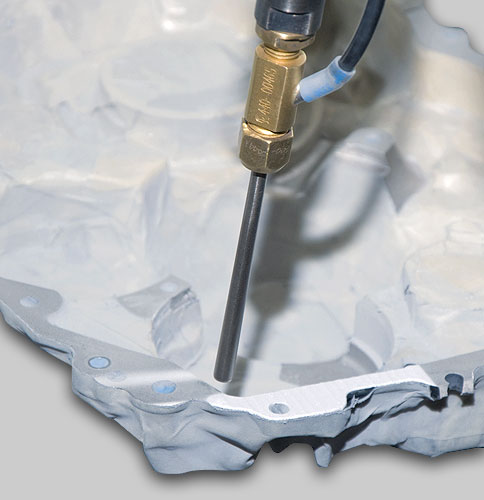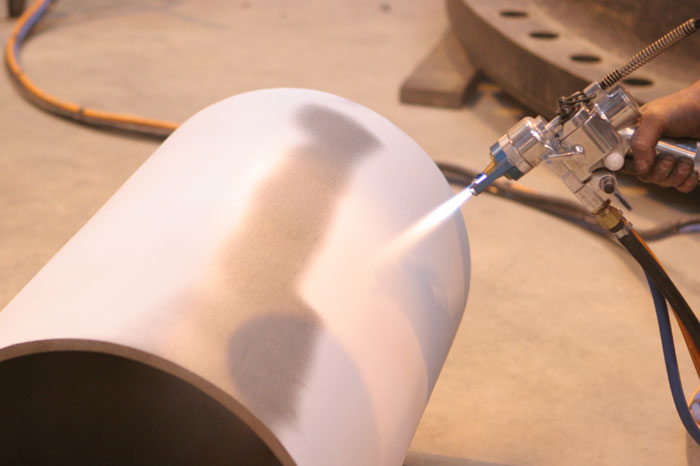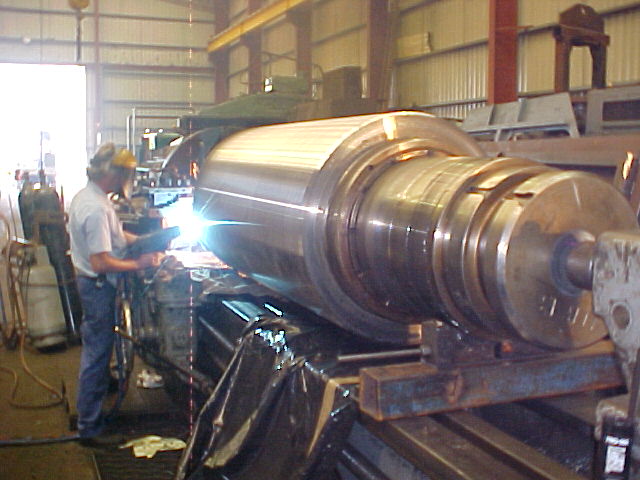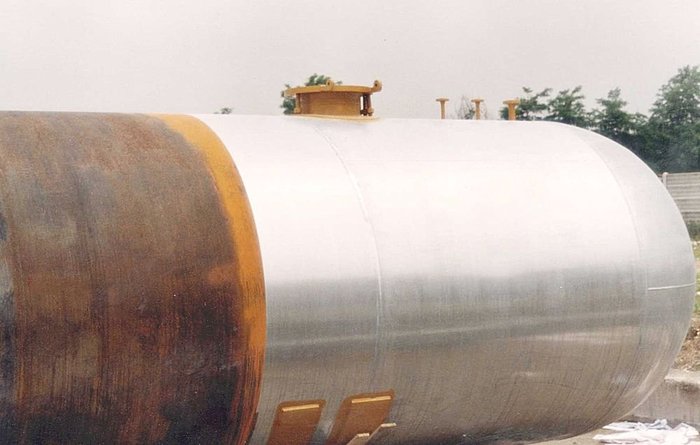Spray Forming
Spray forming, also known as spray casting, spray deposition and in-situ compaction, is a method of casting near net shape metal components with homogeneous microstructures via the deposition of semi-solid sprayed droplets onto a shaped substrate. In spray forming an alloy is melted, normally in an induction furnace, then the molten metal is slowly poured through a conical tundish into a small-bore ceramic nozzle. Deposition continues, gradually building up a spray formed billet of metal on the substrate.
Spray forming, also called spray casting or spray deposition, is the inert gas atomization of a liquid metal stream into variously sized droplets (10-500 microns) that are then propelled away from the region of atomization by the fast flowing atomizing gas.
Professor Singer at the Swansea University first developed the idea of gas atomised spray forming in the 1970s in which a high pressure gas jet impinges on a stable melt stream to cause atomisation. Spray forming has found applications in specialist industries such as: stainless steel cladding of incinerator tubes; nickel superalloy discs and rings for aerospace-engines; aluminium-titanium, aluminium-neodymium and aluminium-silver sputter targets; aluminium-silicon alloys for cylinder liners; and high speed steels. The gas atomised spray forming (GASF) process typically has a molten alloy flow rate of 1–20 kg/min-1, although twin atomizer systems can achieve metal flow rates of up to 80 kg/min-1. Special steel billets of 1 tonne or more have been produced by spray forming on a commercial basis, together with Ni superalloy ring blanks of up to 500 kg and Al alloy extrusion billets of up to 400 kg.
Spray forming offers certain advantages over both conventional ingot metallurgy and more specialised techniques such as powder metallurgy. The atomisation of the melt stream into droplets of 10-500 µm diameter, some of which, depending on diameter, cool quickly to the solid and semi-solid state provide a large number of nucleants for the residual liquid fraction of the spray formed material on the billet top surface. Because of the complex solidification path (i.e. the rapid transition from superheated melt to solid, liquid or semi-solid droplet to temperature equilibration at semi-solid billet top and final slow cooling to fully solid) of the spray formed material, extended solubility of alloying elements and the formation of metastable and quasi-crystalline phases has also been reported.
One of the major attractions of spray forming is the potential economic benefit to be gained from reducing the number of process steps between melt and finished product. Spray forming can be used to produce strip, tube, ring, clad bar / roll and cylindrical extrusion feed stock products, in each case with a relatively fine-scale microstructure even in large cross-sections. There are two major disadvantages to the gas atomisation spray forming process. The most significant disadvantage is the relatively low process yield with typical losses of ~30%. Losses occur because of overspray (droplets missing the emerging billet), splashing of material from the billet surface, and material ‘bouncing’ off the semi-solid top surface. The second major disadvantage is one of process control. It is partly the process complexity and lack of robust process control that has prevented the widespread commercialisation of this process. Porosity resulting from gas entrapment and solidification shrinkage is a significant problem in spray formed materials.
A typical spray formed billet will contain 1-2% porosity with a pore size dependent on alloy freezing range and various process parameters. Large-scale porosity is more difficult to heal effectively and must be minimised by careful process control. In some cases, porosity is controlled by alloy additions which react with dissolved and entrapped gas to form a solid phase e.g. titanium added to copper billets to form titanium nitride with dissolved and entrapped nitrogen gas. In spite of the problems associated with the spray forming process there has been sustained industrial interest in spray forming over the last 35 years. Main applications are prematerial for low temperature Nb3Sn super conductors (CuSn), oil drilling equipment (high strength material CuMnNi) and for forming tools (CuAlFe with high Al-content). In all of these applications, research concerns the reconciliation of the cost disadvantages and complexity of spray forming with the demand for high performance alloys in niche applications.
The next generation melting procedures in spray forming applications were bottom pour induction units, which offer many benefits. In this system, the melting crucible is directly above the atomiser head with a ceramic nozzle feeding directly from the furnace to the atomiser. An alternative approach is the tilt-pour furnace whereby an induction furnace is tilted to pour the melt into a conical tundish that in turn delivers the molten metal to the melt delivery nozzle. The tilt pour system provides the advantage that melting is decoupled from the spraying procedure so that melting problems and remedial solutions do not affect or disturb the critical set-up of the melt delivery nozzle.
In the most complex melting arrangement, used only for production of nickel superalloy turbine forging blanks by spray forming, vacuum induction melting, electroslag re-melting and cold hearth crucibles have been combined by GE to control alloy impurity levels and the presence of refractory inclusions in the molten metal supply. Clean metal spray forming (CMSF) combines the electroslag refining process, cold walled induction guide and gas atomised spray forming. The melt stream exits the melt delivery nozzle into the spray chamber. The melt stream is protected from being destabilised by the turbulent gas environment in the spray chamber by primary gas jets operating at intermediate inert gas pressure of 2 to 4 bar, the resulting gas flow is parallel to the melt stream to stabilise the melt stream. The secondary atomiser uses high velocity (250 to 350 m/s), high-pressure (6 to 10 bar) gas jets to impinge on the melt stream to achieve atomisation. Typical droplet diameters follow a log-normal distribution with powder diameters up to ~600 µm with a mass median diameter of ~150 µm.
The atomising gas mass flow rate to molten metal mass flow rate ratio is a key parameter in controlling the droplet diameter and hence the cooling rate, billet temperature and resulting solid particle nucleant density. The gas-metal ratio (GMR) is typically in the range 1.5 to 5.5, with yield decreasing and cooling rates in the spray increasing with increasing GMR. By using programmable oscillating atomiser drives it was possible to improve the shape and shape reproducibility of spray formed deposits. It has been demonstrated that parallel sided, flat topped billets could be sprayed in a reproducible manner if the substrate rotation and atomiser oscillation frequency were synchronised and optimised for specific alloys and melt flow rates. Twin atomiser systems combine a static and scanning atomiser, making it possible to spray billets of up to 450 mm diameter with economic benefits.
You might also like
| Cold Metal Spraying How Does Cold Spray Work ? In the 1990s,... | Types of Metal Spraying Metal Spraying Types Thermal Spray, Spray... | Metal Spraying What is Metal Spraying ? Metal spraying... | Anti Corrosion What is Rust Inhibitor ? Anti-corrosion... |




 Alloy Suppliers
Alloy Suppliers
 Aluminum
Aluminum
 Aluminum Extrusions
Aluminum Extrusions
 Copper-Brass-Bronze
Copper-Brass-Bronze
 Nickel
Nickel
 Magnets
Magnets
 Stainless Steel
Stainless Steel
 Stainless Steel Tubing
Stainless Steel Tubing
 Steel Service Centers
Steel Service Centers
 Titanium
Titanium
 Tungsten
Tungsten
 Wire Rope
Wire Rope